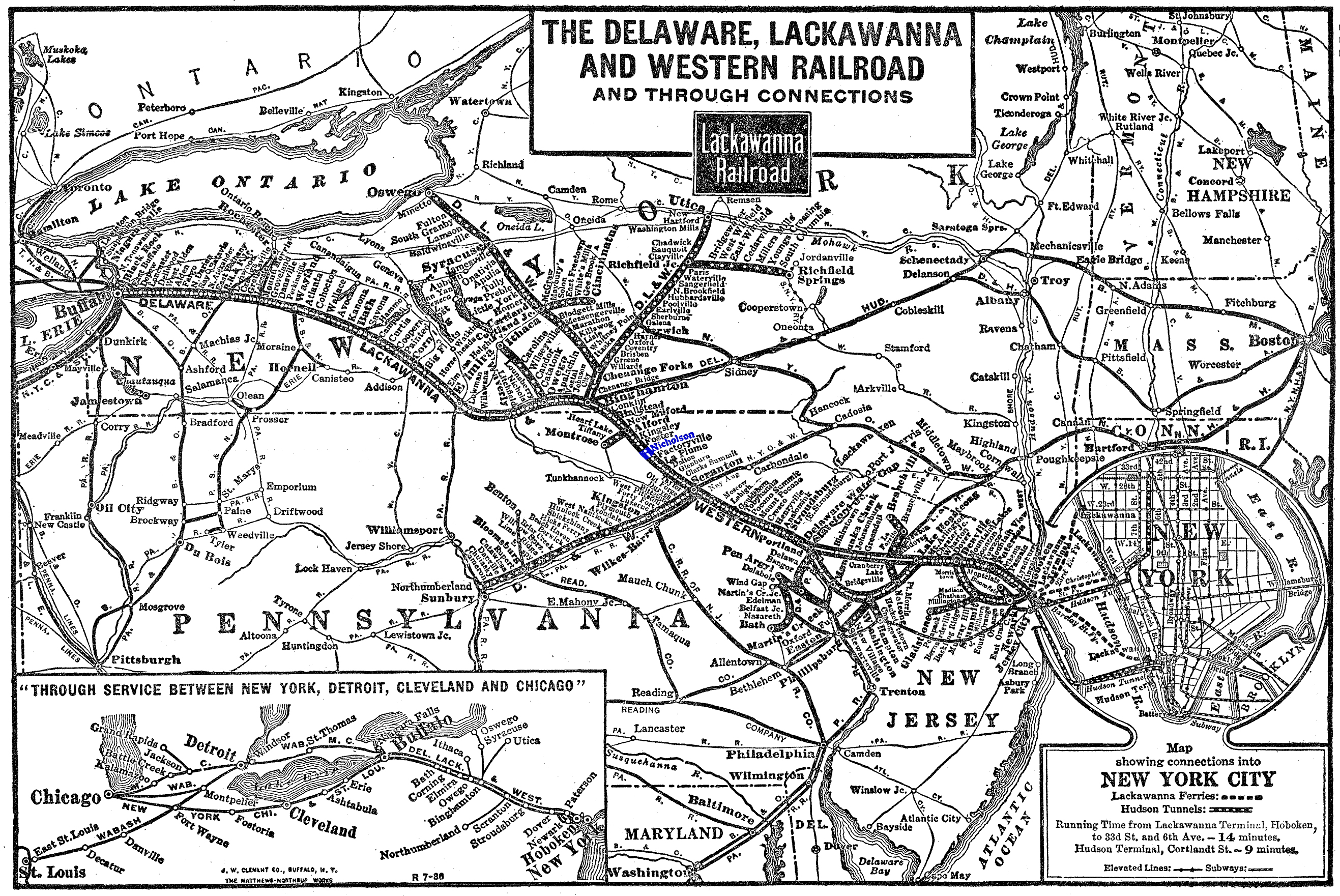Tunkhannock Viaduct (PA): The Nicholson Bridge
Last revised: August 24, 2024
By: Adam Burns
The Lackawanna's Tunkhannock Viaduct (sometimes also known as the Nicholson Bridge) was its crowning achievement of its second cut-off located in northeast Pennsylvania and southern New York.
The viaduct was primarily built as part of the DL&W Railroad's project to shorten the rail route between Scranton, Pennsylvania and Binghamton, New York by 3.6 miles. This major feat of engineering provided a direct and efficient route for the transportation of goods and passengers, facilitating economic growth in the region.
Around the turn of the 20th century the DL&W began to look at ways to straighten and flatten its route to Buffalo, New York in an attempt to be more competitive with nearby railroads.
To do so the Lackawanna used two cut-offs, one that straddled the Pennsylvania and New Jersey borders known as the New Jersey Cutoff and, later, another in upstate Pennsylvania known as the Nicholson-Hallstead Cutoff.
It may come as a surprise to many that this towering structure was built exclusively with reinforced concrete, a popular building material of the time. Approximately 169,000 cubic yards of concrete was poured to construct this engineering marvel, signifying a bold, unprecedented approach to bridge construction at the time.
The latter engineering project is where the massive viaduct is located and was so immense that it held the world's record as the largest concrete bridge for more than a half-century.
As of today, the Tunkhannock Viaduct is not just a testament to past glory but a living piece of history still in use. The bridge remains operational and is presently under the stewardship of the Norfolk Southern Railway, an American freight railroad.
History
The Lackawanna of this era was a prodigiously successful railroad, enjoying a bountiful supply of anthracite coal from mines predominantly located in eastern Pennsylvania.
The railroad was also managed to extreme precision and never experienced a bankruptcy during its lifetime. These traits allowed the company to carry out such incredible engineering feats. Today, Tunkhannock Viaduct remains in use by owner Norfolk Southern.
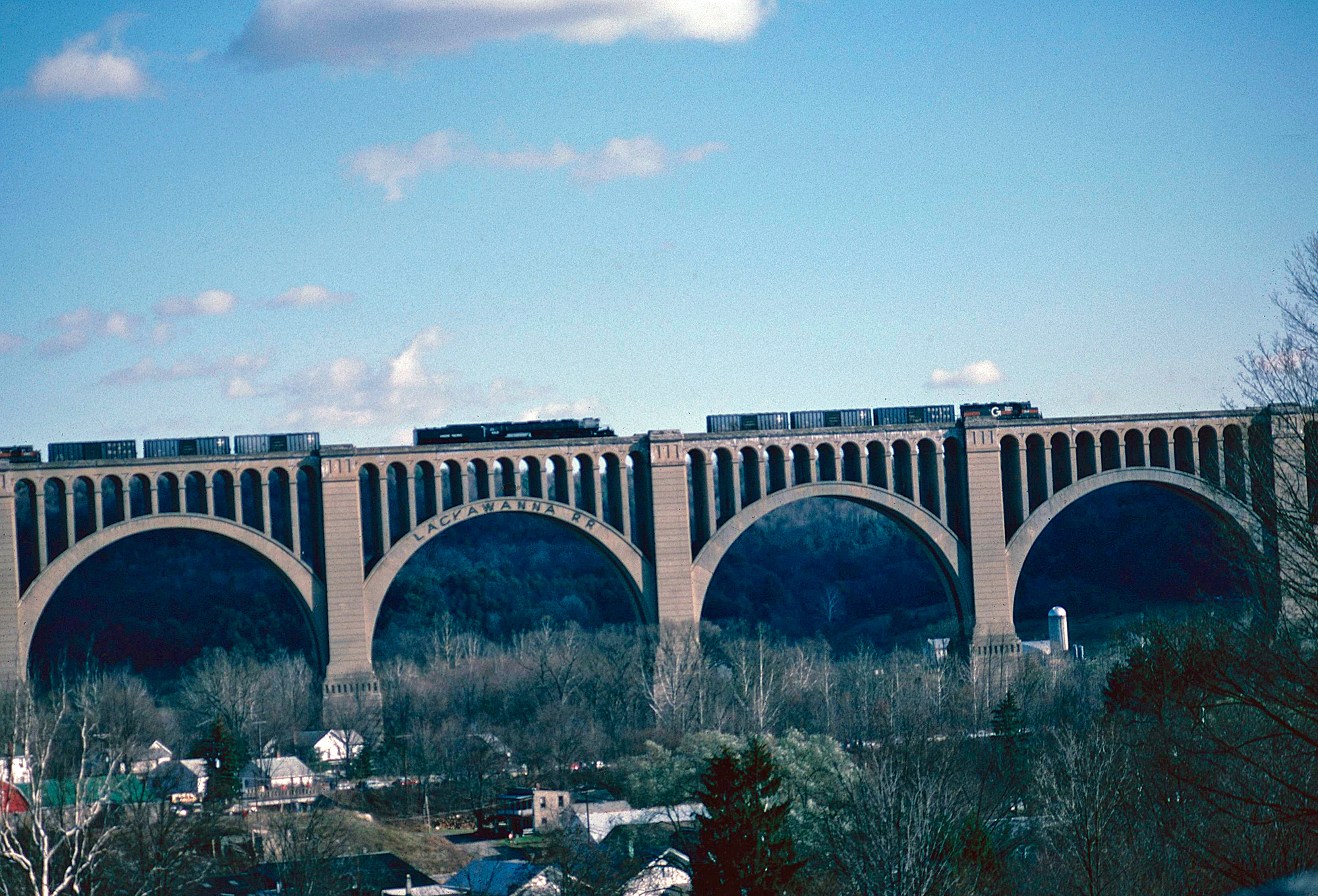 Guilford GP39-2 #366 (Boston & Maine) and U23B #293 (Maine Central) ease Union Pacific 4-8-8-4 "Big Boy" #4012 across Tunkhannock Viaduct on November 17, 1984. The locomotive was on its way from the original Steamtown in Bellows Falls, Vermont to the new display now located in Scranton, Pennsylvania. Greg Whittle photo. American-Rails.com collection.
Guilford GP39-2 #366 (Boston & Maine) and U23B #293 (Maine Central) ease Union Pacific 4-8-8-4 "Big Boy" #4012 across Tunkhannock Viaduct on November 17, 1984. The locomotive was on its way from the original Steamtown in Bellows Falls, Vermont to the new display now located in Scranton, Pennsylvania. Greg Whittle photo. American-Rails.com collection.Delaware, Lackawanna & Western
The Delaware, Lackawanna and Western Railroad officially has its beginnings in 1851 when in October 20th of that year the Lackawanna & Western Railroad operated its first scheduled train between Scranton and Great Bend, Pennsylvania (originally the L&W was known as the Liggetts Gap Railroad until it changed its name in 1851).
At A Glance
The Lackawanna gained its name in March of 1853 when it merged with the Delaware & Cobbs Gap Railroad (which constructed a line south of Scranton) to form the Delaware, Lackawanna and Western Railroad.
Although the DL&W would have a number of smaller railroads making up its system the final integral pieces of the railroad was the Morris & Essex (which built a line between Newark and Morristown, New Jersey) and New York, Lackawanna & Western (which built a line between Binghamton and Buffalo, New York).
Map (1936)
With the ownership of these lines the DL&W's main line was basically complete and, in all, stretched from Buffalo, New York to Hoboken, New Jersey just across the Hudson River from downtown New York City (Manhattan).
The DL&W's Tunkhannock Viaduct is located in Nicholson, Pennsylvania (thus why it is sometimes called Nicholson Bridge/Viaduct) located a little more than 20 miles north of Scranton. The viaduct spans the Tunkhannock Creek and while the stream itself the valley itself is, which forced the railroad to build such a massive structure.
The idea of the DL&W leveling and straightening its main line to Buffalo began around 1900 and was the result of its president William Haynes Truesdale, which not only wanted the railroad to be more competitive in the New York City-Buffalo market but also wished to alleviate a curving and meandering route through much of northeastern Pennsylvania that was slow, steep, and circuitous.
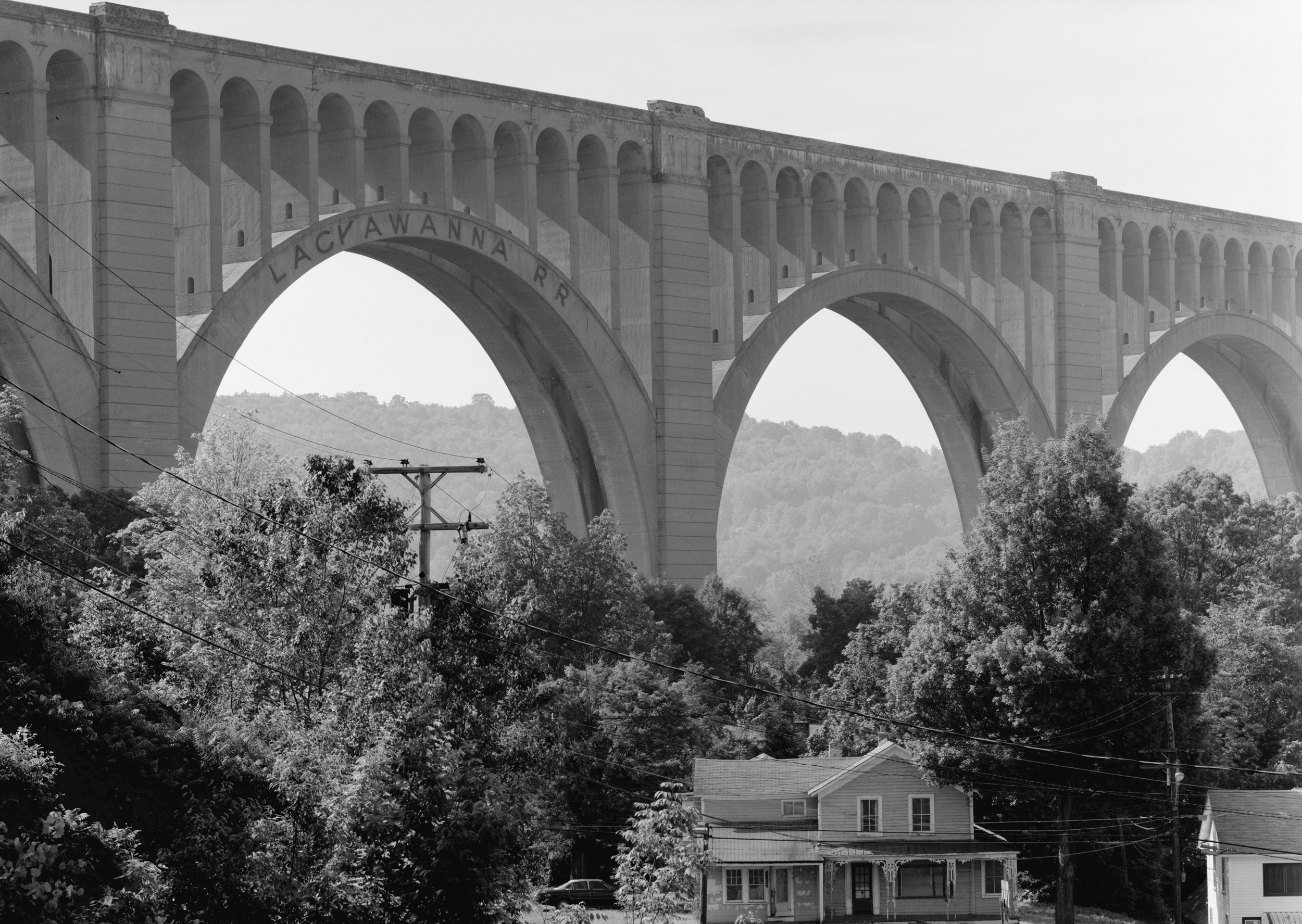 A close-up view of Tunkhannock Viaduct, taken at the same time as the photo above. The Delaware, Lackawanna & Western, a proud and then powerful railroad, made sure there was little doubt regarding who owned the structure.
A close-up view of Tunkhannock Viaduct, taken at the same time as the photo above. The Delaware, Lackawanna & Western, a proud and then powerful railroad, made sure there was little doubt regarding who owned the structure.Construction
The Tunkhannock Viaduct, often referred to as the Nicholson Bridge, is a marvel of engineering history located in the United States. It was designed by the renowned engineer Abraham Burton Cohen and was built during a remarkable period of ambitious railroad construction by the Delaware, Lackawanna, and Western Railroad (DL&W).
Working from east to west the
New Jersey/Lackawanna Cutoff was built between 1908 and 1911 at a cost
of $11 million. While this route was only about 28.5 miles in length it
shaved more than 11 miles of redundant trackage and reduced the ruling
grade by more than half.
A year later the Lackawanna began the Nicholson-Hallstead Cutoff, which ultimately cost $14 million covering just under 40 miles. While the new alignment only saved the DL&W about 3.5 miles it eliminated many curves and grades.
The viaduct began was designed by Abraham Burton Cohen and began construction in May of 1912. The project was marked by incredible efficiency, with work carried out around the clock by a crew of as many as 500 workmen.
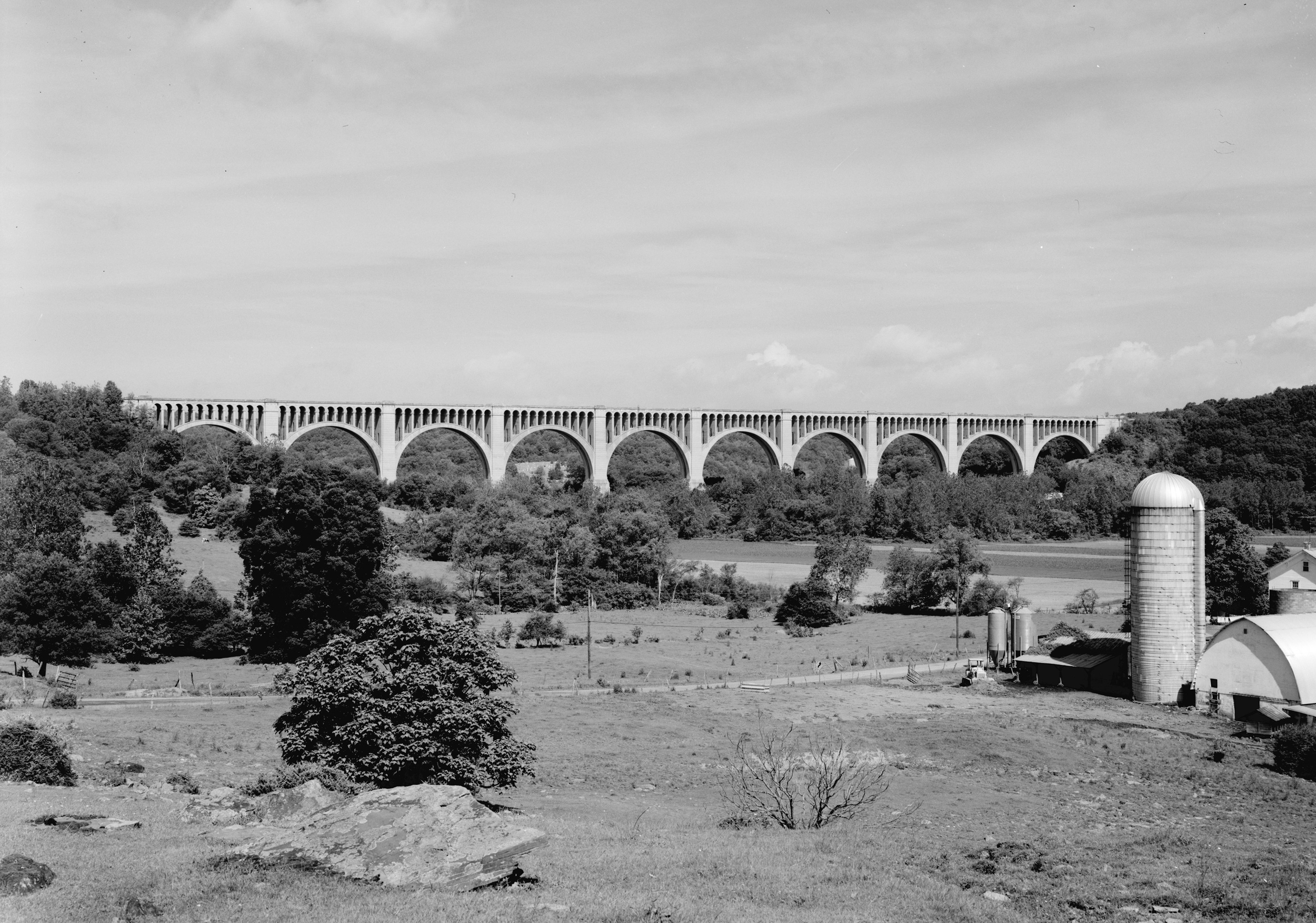 A westward view of Tunkhannock Viaduct looking towards Nicholson, Pennsylvania in a scene taken during the Erie Lackawnna era.
A westward view of Tunkhannock Viaduct looking towards Nicholson, Pennsylvania in a scene taken during the Erie Lackawnna era.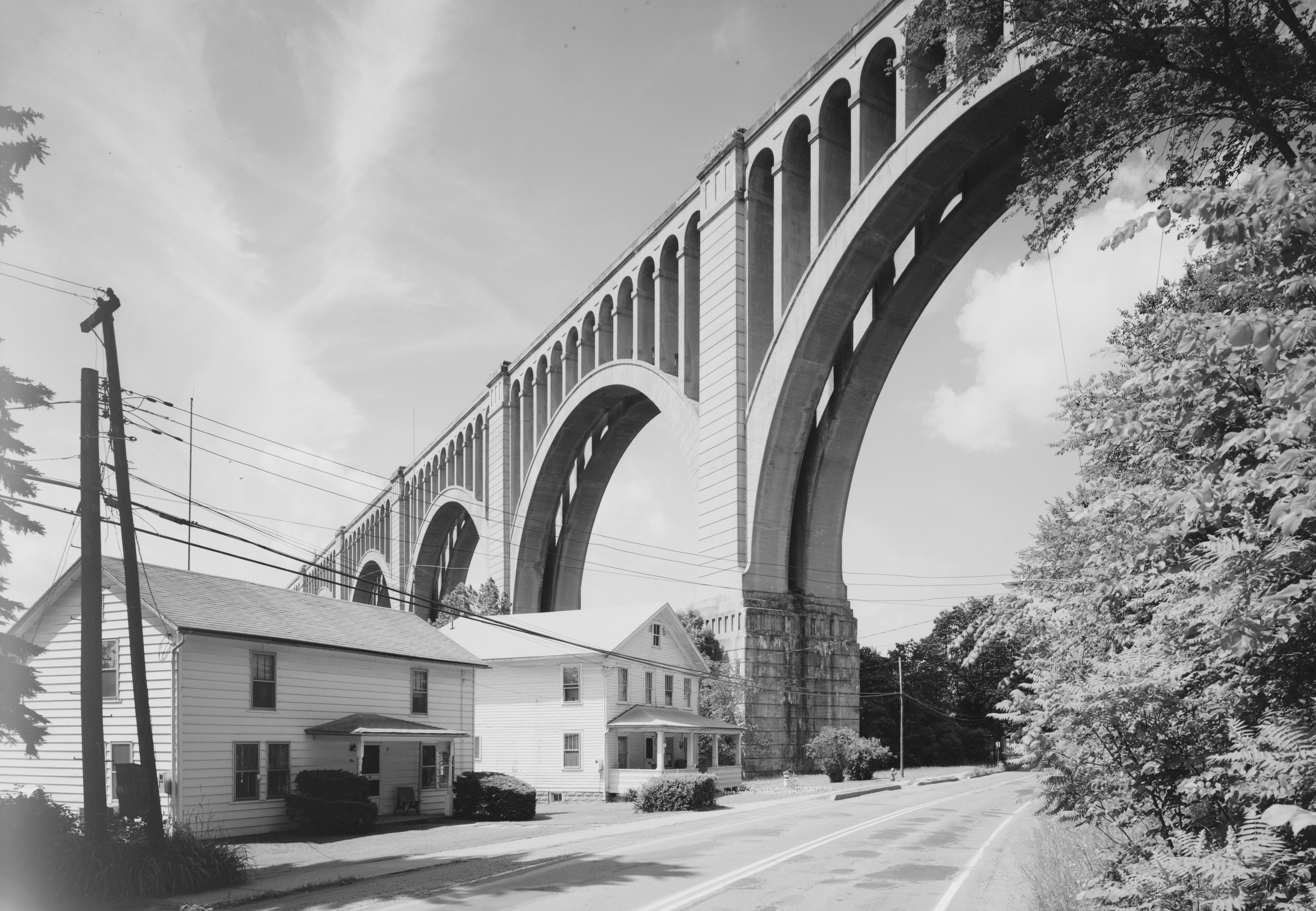 A ground-level view of the viaduct's massive arches, which spanned some 240 feet above the valley floor.
A ground-level view of the viaduct's massive arches, which spanned some 240 feet above the valley floor.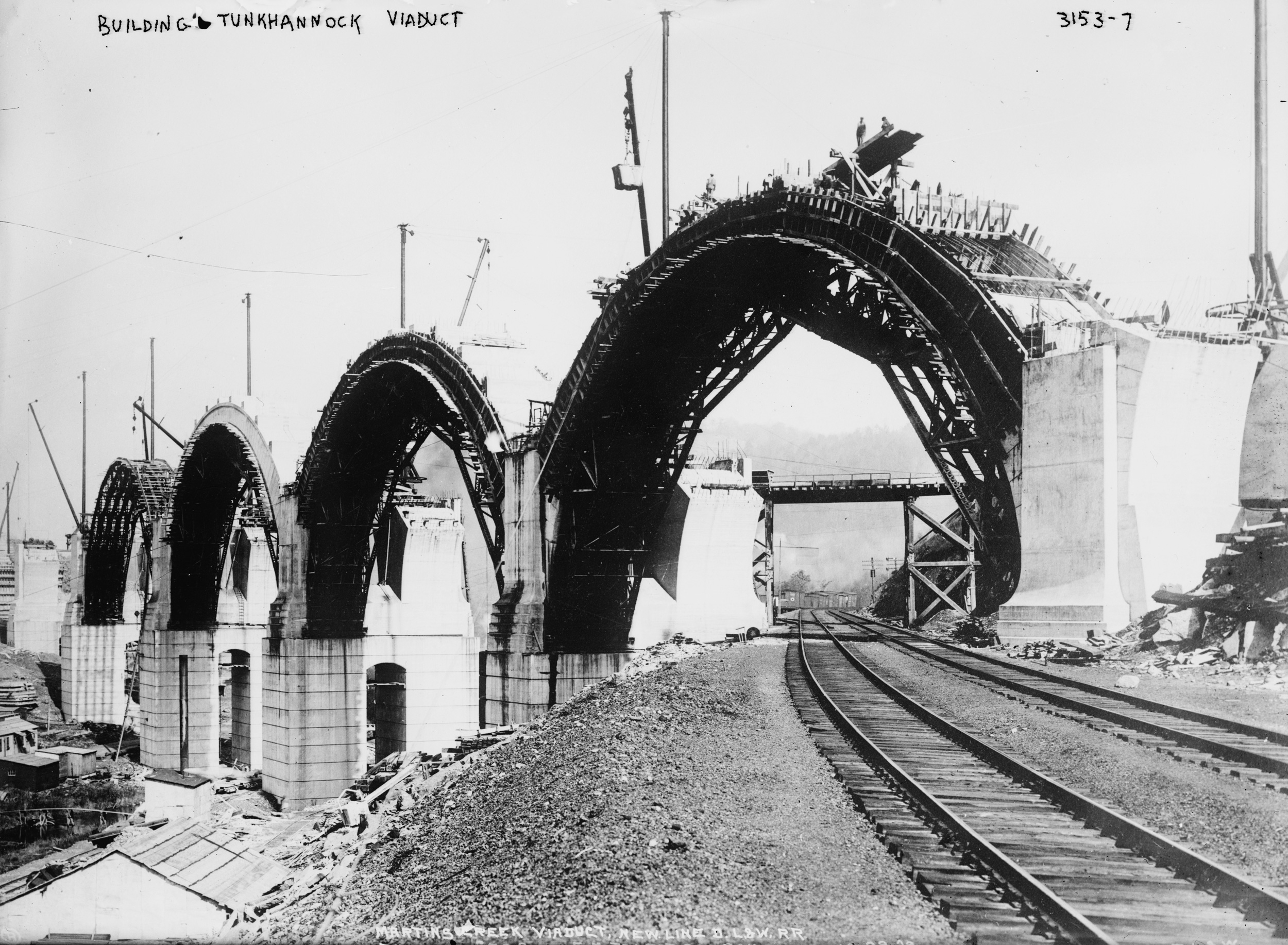 A view of Tunkhannock Viaduct under construction on October 22, 1913. You can see the old main line passing beneath the structure.
A view of Tunkhannock Viaduct under construction on October 22, 1913. You can see the old main line passing beneath the structure.The massive bridge was built by contractor, Flickwir & Bush, and utilized concrete - a material readily available all along the Lackawanna's network. In fact, concrete was chosen not only for bridge construction but also many other DL&W infrastructure projects such as interlocking towers, stations, and various lineside structures.
To span the valley Cohen determined the viaduct would need thirteen pier supports, which spanned not only 240-feet to the valley floor but also an additional 138-feet underground to reach bedrock.
The bridge, which was designed for two tracks, features ten arched spans overall which cover the length of the valley at an astounding 2,375 feet (or more than a half-mile). Overall it took 168,000 cubic yards of concrete to build Tunkhannock.
It's not just its length that commands attention, it also soars to a height of 240 feet, an impressive height considering the era in which it was constructed.
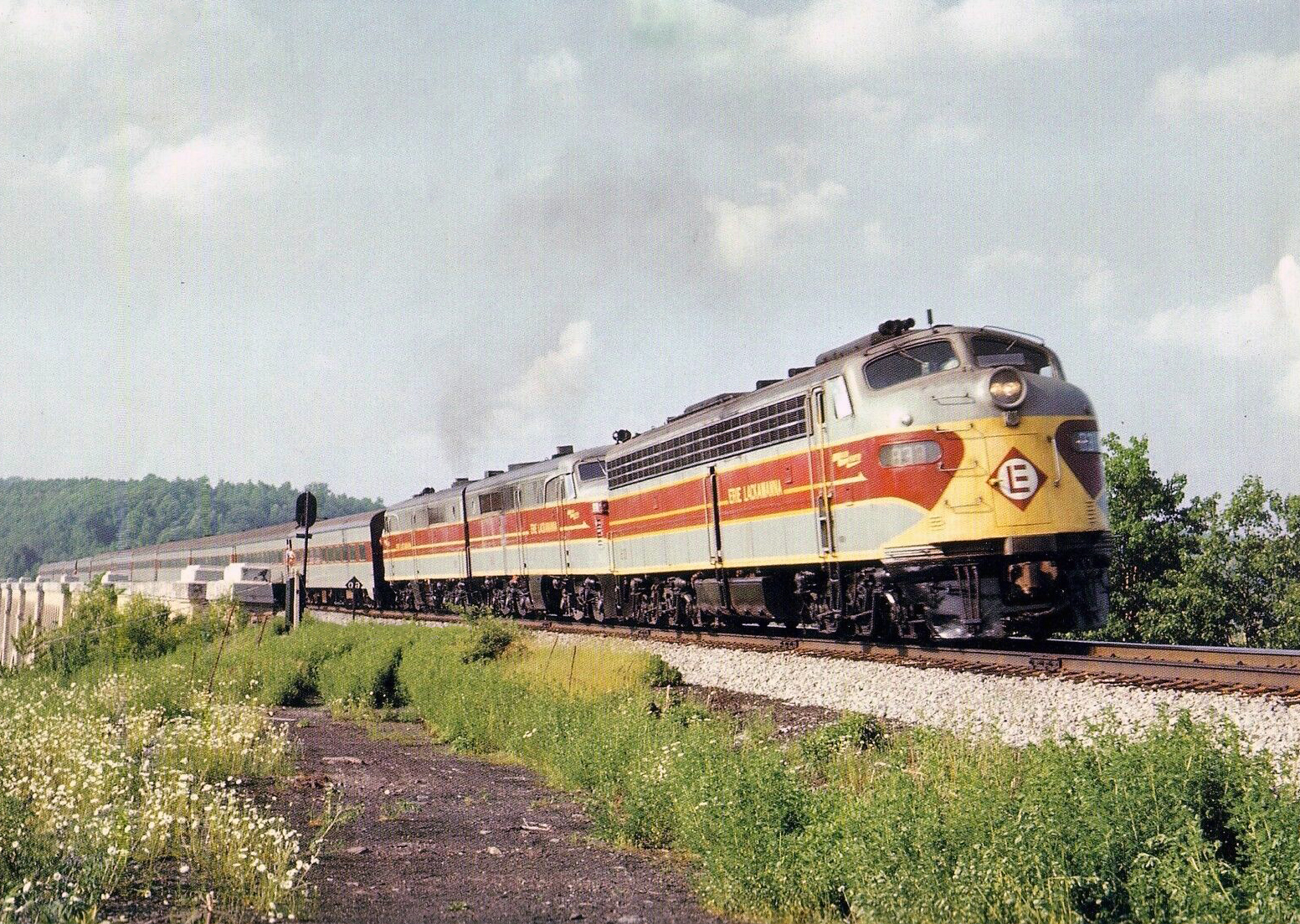 An Erie Lackawanna E8A, and a pair of PA's, lead a farewell excursion to the venerable Alco's over Tunkhannock Viaduct in June, 1968.
An Erie Lackawanna E8A, and a pair of PA's, lead a farewell excursion to the venerable Alco's over Tunkhannock Viaduct in June, 1968.Operation
Despite the length and enormity of the viaduct, incredibly the bridge was completed in just about 3 1/2 years, opening on November 6, 1915.
The accomplishment was hailed as a triumph of engineering and workmanship, a testimonial of American industrial might.
Upon its completion, which was marked by a grand ceremony, the Viaduct was the world's largest concrete bridge. This title and the impressive speed of its construction gained it considerable attention, both locally and internationally. Its opening was met with great fanfare, a manifestation of America's progressive and illustrious railroad era.
The Tunkhannock Viaduct primarily served freight traffic for the DL&W Railroad, which was vital for the anthracite coal industry dominant in northeastern Pennsylvania at the time. It also facilitated passenger traffic, enhancing connectivity in the region.
Over the years, the Viaduct remained a crucial transportation artery, serving multiple railroads as ownership changed due to mergers and acquisitions. Despite these transitions, the bridge continued to fulfill its original role effectively and reliably.
The Tunkhannock Viaduct held its own against the test of time and elements, with the bridge currently over a century old. It has endured through significant weather changes and even seismic activities without major structural damage - a true testament to its sturdy construction and meticulous design.
Apart from its utilitarian purpose, the Viaduct makes for a splendid sight and has become an attraction for both locals and tourists. It astounds onlookers with its sheer measurement and the grandeur of the surrounding landscape it spans.
The Tunkhannock Viaduct is not just a bridge but a symbol of American ingenuity and industrial strength. It embodies the nation's advancement during the early 20th century, and its enduring presence continues to be a source of pride and admiration for many.
It remained in operation on the DL&W until 1960 when the railroad merged with the Erie to form the Erie Lackawanna, which continued to use the former Lackawanna main line.
After the EL's bankruptcy and inclusion into Conrail in 1976 the route was sold to the Delaware & Hudson Railway, which continued to use Tunkhannock until it came under Canadian Pacific control for many years until being sold to Norfolk Southern. Today, Norfolk Southern itself still uses this National Historic Engineering Landmark, which is also listed on the National Register of Historic Places.
National Historic Civil Engineering Landmark
The Viaduct's monumental significance was recognized officially when it was designated as a National Historic Civil Engineering Landmark by the American Society of Civil Engineers in 1975. It continues to hold this prestigious title, speaking volumes of its historical and architectural importance.
Legacy
Through its history, the Viaduct provides valuable insights into the progression of bridge engineering and construction methods during the early 20th century. Its design and construction influenced future railroad bridge projects, leaving an indelible mark in the annals of civil engineering.
Interestingly, the viaduct, due to its impressive size and unique construction, has often been mistaken as an aqueduct by the uninformed. However, this misconception has only led to increased curiosity and interest in learning more about this historical bridge.
The Tunkhannock Viaduct has even been incorporated into various popular culture narratives and symbols. It has been featured in several works of art, media, and literature, accentuating its iconic status in northeastern Pennsylvania and beyond.
Considerable efforts have been made to preserve the Viaduct due to its historical significance and continued utility. Periodic inspections and maintenance work ensure that the Nicholson Bridge continues to stand tall and serve its purpose efficiently.
The story of the Tunkhannock Viaduct does not end with its static existence. Its great expanse, towering height, and continued usage have helped generate intriguing tales, art, and social responses, enriching its historical tapestry with unique local color and significance.
While the Viaduct had initially been built to serve practical railroad needs, it has transformed into a symbol of enduring strength, breathtaking scale, and historical significance. The Tunkhannock Viaduct, hence, continues to garner admiration and curiosity a century after its completion.
In conclusion, the Tunkhannock Viaduct, or the Nicholson Bridge, remains a remarkable monument of engineering prowess and vision. Much more than a vital link in the Delaware, Lackawanna, and Western Railroad network, its grandeur and enduring legacy continues to inspire awe and respect.
The Viaduct stands as a silent reminder of a fascinating chapter in America's railroad history, rightfully maintaining its place as one of the nation's most significant and admired engineering landmarks.
Recent Articles
-
Oregon Railroad Museums: A Complete Guide
Apr 25, 25 03:11 PM
With its rich tapestry of scenic landscapes and profound historical significance, Oregon possesses several railroad museums that offer insights into the state’s transportation heritage. -
North Carolina Railroad Museums: A Complete Guide
Apr 25, 25 02:56 PM
Today, several museums in North Caorlina preserve its illustrious past, offering visitors a glimpse into the world of railroads with artifacts, model trains, and historic locomotives. -
New Jersey Railroad Museums: A Complete Guide
Apr 25, 25 11:48 AM
New Jersey offers a fascinating glimpse into its railroad legacy through its well-preserved museums found throughout the state.
